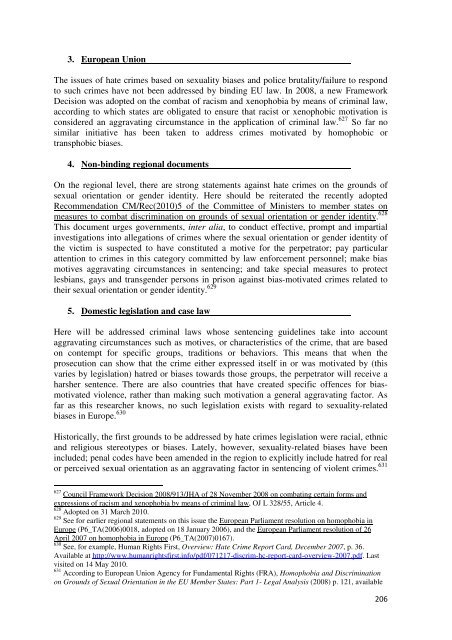Johanna Westeson - The ICHRP
Johanna Westeson - The ICHRP
Johanna Westeson - The ICHRP
You also want an ePaper? Increase the reach of your titles
YUMPU automatically turns print PDFs into web optimized ePapers that Google loves.
3. European Union<br />
<strong>The</strong> issues of hate crimes based on sexuality biases and police brutality/failure to respond<br />
to such crimes have not been addressed by binding EU law. In 2008, a new Framework<br />
Decision was adopted on the combat of racism and xenophobia by means of criminal law,<br />
according to which states are obligated to ensure that racist or xenophobic motivation is<br />
considered an aggravating circumstance in the application of criminal law. 627 So far no<br />
similar initiative has been taken to address crimes motivated by homophobic or<br />
transphobic biases.<br />
4. Non-binding regional documents<br />
On the regional level, there are strong statements against hate crimes on the grounds of<br />
sexual orientation or gender identity. Here should be reiterated the recently adopted<br />
Recommendation CM/Rec(2010)5 of the Committee of Ministers to member states on<br />
measures to combat discrimination on grounds of sexual orientation or gender identity. 628<br />
This document urges governments, inter alia, to conduct effective, prompt and impartial<br />
investigations into allegations of crimes where the sexual orientation or gender identity of<br />
the victim is suspected to have constituted a motive for the perpetrator; pay particular<br />
attention to crimes in this category committed by law enforcement personnel; make bias<br />
motives aggravating circumstances in sentencing; and take special measures to protect<br />
lesbians, gays and transgender persons in prison against bias-motivated crimes related to<br />
their sexual orientation or gender identity. 629<br />
5. Domestic legislation and case law<br />
Here will be addressed criminal laws whose sentencing guidelines take into account<br />
aggravating circumstances such as motives, or characteristics of the crime, that are based<br />
on contempt for specific groups, traditions or behaviors. This means that when the<br />
prosecution can show that the crime either expressed itself in or was motivated by (this<br />
varies by legislation) hatred or biases towards those groups, the perpetrator will receive a<br />
harsher sentence. <strong>The</strong>re are also countries that have created specific offences for biasmotivated<br />
violence, rather than making such motivation a general aggravating factor. As<br />
far as this researcher knows, no such legislation exists with regard to sexuality-related<br />
biases in Europe. 630<br />
Historically, the first grounds to be addressed by hate crimes legislation were racial, ethnic<br />
and religious stereotypes or biases. Lately, however, sexuality-related biases have been<br />
included; penal codes have been amended in the region to explicitly include hatred for real<br />
or perceived sexual orientation as an aggravating factor in sentencing of violent crimes. 631<br />
627 Council Framework Decision 2008/913/JHA of 28 November 2008 on combating certain forms and<br />
expressions of racism and xenophobia by means of criminal law, OJ L 328/55, Article 4.<br />
628 Adopted on 31 March 2010.<br />
629 See for earlier regional statements on this issue the European Parliament resolution on homophobia in<br />
Europe (P6_TA(2006)0018, adopted on 18 January 2006), and the European Parliament resolution of 26<br />
April 2007 on homophobia in Europe (P6_TA(2007)0167).<br />
630 See, for example, Human Rights First, Overview: Hate Crime Report Card, December 2007, p. 36.<br />
Available at http://www.humanrightsfirst.info/pdf/071217-discrim-hc-report-card-overview-2007.pdf. Last<br />
visited on 14 May 2010.<br />
631 According to European Union Agency for Fundamental Rights (FRA), Homophobia and Discrimination<br />
on Grounds of Sexual Orientation in the EU Member States: Part 1- Legal Analysis (2008) p. 121, available<br />
206
















